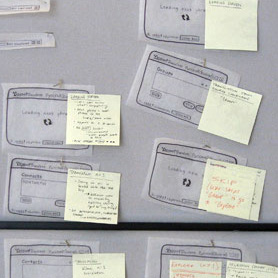Maureen Hanratty
Freelance User Experience Designer
Primary design concentration:
Interaction Design
Most preferred tool for designing:
Sharpies and Tracing paper
1. How and why did you choose to become a designer?
I stumbled into design when applying for graduate school. I had work experience as an information professional, so I looked at library and information science schools. There was a specialization called Human-Computer Interaction and I thought, hmm maybe I could do this and leverage some of my visual design skills from being a painter. If it didn’t work out I could always go back to the more library type stuff. Then it dawned on me my first semester that design fit me much better than fine art because it’s a mix of creative and analytical. And I was born to make stuff rather than organizing it.
2. Challenges you encounter as a designer and how do you deal with them?
Design is the easy part. The real challenge is convincing other people to implement what you’ve designed. Design reviews with engineers can be brutal. I use an interviewing technique where I repeat back to the person what I they just told me, ala “So you are saying x, y, z. Is that correct?” This makes the person feel that their point has been heard and considered. Then I can give my justifications for the design. Even if I have clear justifications, I still get push back. At this point, it’s better to move on. I find that my reasoning often doesn’t seep in until a day or two after the meeting.
3. Your definition of an “elegant solution,” that is, good design?
An elegant solution withstands the test of time. As an industrial design professor once told me, design should have an “enduring quality.” This enduring quality hinges on the design’s flexibility, its ability to be reused and repurposed. The boxy buildings of modern architecture endure in our skylines because their open floor plans are so easy to reconfigure for living and work spaces. Good design is humble and even hackable. And like a favorite threadbare t-shirt, well-designed objects end up in the garbage heap not because they are deficient in any way, but because their owners loved them a little too much.
4. From skills to values, what makes a designer successful?
A designer must have guts. A good designer never knows when to stop questioning, unnerving everyone around them. A successful designer is fearless, reckless, and ignorant.
5. How do you stay motivated and grow personally and professionally as a designer?
I keep motivated by reading lots of books and articles about design. I’m the local coordinator for the San Francisco UX Book Club which ensures that I read at least one UX book per month. I also try to do design outside of work, like participating in Mozilla Labs Design Challenges.
6. For those aspiring to become a designer, whatever the discipline,what is your advice?
If you work hard in very focused way, then you will be successful. When I was in art school, I was constantly changing the type of work that I did. I was interested in ideas rather than craft. I looked down on the people who did one type of work week after week, year after year. Then I saw our senior show and how advanced their painting had become, and how pathetic and amateurish my own work looked. You will never get anywhere going a thousand different directions.
7. What is your quest in design?
I’m not sure what my quest is, though I know what it is not. It is not to make flashy, “look-at-me” design. It is not to make disposable, “of the moment” design. I do desire to make meaningful things that add value and delight to people’s lives. And I hope to contribute to a meaningful discussion about design and the place it holds in our individual lives and our culture.
Previous: Chantal van Gogh | Next: Elizabeth Joy Gershenzon and Travis Kochel

Support this solo initiative
What began as a collection of links has evolved into a comprehensive archive committed to creative culture—offering so far 395 interviews with under-the-radar Artists, Designers & Makers, in addition to 202 write-ups across events, books, movies, more. Free to explore. Free from ads. If you gain a level of motivation, knowledge, even delight, from Design Feast, please support on Patreon. Thanks for your consideration!
Wishing you continual success,
Nate Burgos, Content Creator & Publisher
Comments
There are no comments yet.
Leave Your Comment